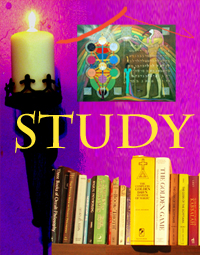Mundus Imaginalis
Mundus Imaginalis
By Harry Wendrich, 2019
As Magicians and Priestesses of the Divine Light, working in the arena of the Astral Realms and Aethyrs of old, invoking Beings out of the need for knowledge, we are constantly challenged when it comes to expressing what we know to be real. When the agnostic asks the question: “How do you arrive at this conclusion?” the response “Using the imagination, via meditation,” often invokes a smirk which reveals how the term ‘imagination’ is equated with fantasy, while ‘meditation,’ even among occultists, is considered a questionable experience with purely subjective results.
Language defines our reality. The prime focus of the English language is to elucidate the environment that we inhabit, but in-so-doing, it risks entrapping our awareness into the physical realm. Carl Jung (1875 – 1961) introduced the terms ‘Active Imagination’ and ‘Collective Unconscious,’ but it is in the work of the French philosopher and Professor of Islamic Studies, Henry Corbin (1903 – 1978) where we find a term that can uphold the view of the multi-levelled reality which can be accessed via meditation.
In his book, Swedenborg and Esoteric Islam, Corbin presents some of the ideas and experiences of a 12th Century Persian mystic, Suhrawardi (1154 – 1191 AD), who became known as a Master of Illumination. Suhrawardi wrote that “…there was among the ancient Persians a community of people guided by God, who thus walked the true way.”[1] It became Suhrawardi’s mission to resurrect the ancient pre-Islamic Zoroastrian philosophy of light and make it very clear that the visionary spiritual experience was as real as the observation of the astronomers of his time.
In a state of “passive potency” (i.e. meditation), Suhrawardi discovered an inner voyage to what he called Nā-Kojā-Ābād – “the Country of No-where” – which could be found on no physical map but was nevertheless just as real. Corbin writes how, in his al-Muṭāraḥāt (“Book of Conversations”), Suhrawardi describes “a world which, while having dimension and extension, is other than the world of the sensory phenomena, and superior to it.”[2] Suhrawardi’s visionary experiences within this realm reflected his level of consciousness.
Corbin could not justify using the term “Imagination” to explain Suhrawardi’s experiences, and derived the Latin phrase Mundus Imaginalis (“the Imaginal World”) to represent Nā-Kojā-Ābād. Corbin thus brought into our esoteric vernacular the “Imaginal,” to describe the realms entered by the Active Imagination.
Suhrawardi described the imagination as the spiritual vehicle of the soul, and Nā-Kojā-Ābād (the Imaginal) as the internal aspect of the soul. The Imagination thus becomes the vehicle or organ needed to explore the Imaginal: it has the ability to see, hear and feel – performing the functions of the physical senses on a spiritual level. The soul, far from being trapped by the physical body, surrounds and moulds it into being.
Henry Corbin saw similarities with the theosophies of Suhrawardi and Emmanuel Swedenborg (1688 – 1772), a Swedish Lutherian theologian, scientist and philosopher. Swedenborg claimed to have had a spiritual awakening where the Lord opened his spiritual eyes so that he could freely visit and communicate with angels and demons. Swedenborg also claimed that things in heaven appear just as in the world, and that changes in the spiritual world affect the physical world: the Imaginal affects the physical, according to one’s level of consciousness.
Swedenborg also put forward the idea that our very ancient ancestors had at one time their awareness set within the spiritual world (the Imaginal) and used their physical senses as tools to define space and time within the physical, but that the consciousness of their descendants became locked within the physical, no longer able to perceive the Imaginal at will, rendering them spiritually blind.
Both Suhrawardi and Swedenborg seemed to understand that as long as humanity has a cosmology that encompasses a multi-dimensional reality, the imagination can function as a healthy organ that seeks knowledge from within the spiritual realms. In a purely physical cosmology, the imagination becomes imbalanced and undervalued, considered solely as the faculty of make-believe. Swedenborg suggested that we are asleep, as long as we deny the reality of the Imaginal, and that our night vision is a reminder of a world lost to us, beckoning us to return.
Master Suhravardi was murdered by fundamentalists who could not contest his use of hermeneutics. This should alert us to a dark side to awakening within the Imaginal – there is more to combat than our own inertia to meditate – a strong opposition that feeds on fear and human suffering acts as an obstacle to individuals, but which cannot hold back a mass awakening. Our first experience of becoming consciously aware of the Imaginal comes through the manifestation of spiritual need – never more clear than today, as our world leaders stumble from one disaster to the next. As we look over the precipice of the unknown, perhaps humanity, as did our ancestors, should be looking to raise our consciousness into Mundus Imaginalis once again.
………..
© Harry Wendrich, 2019
Further reading:
Lost Knowledge of the Imagination, Gary Lachman
Swedenborg and Esoteric Islam, by Henry Corbin
[1] Henry Corbin, “The Voyage and the Messenger: Iran and Philosophy”, North Atlantic Books, 1998, p. XLV
[2] Henry Corbin, “Swedenborg and Esoteric Islam”, trans. Leonard Fox, Swedenborg Foundation, 2014, p.8
